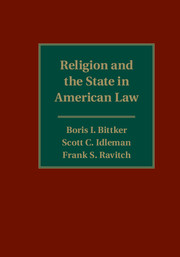Book contents
- Frontmatter
- Dedication
- Contents
- Preface
- 1 History and Introduction
- 2 Church and State in the Nineteenth Century
- 3 Religious Influences and Expressions in Law and Government
- 4 The Establishment Clause
- 5 The Free Exercise Clause
- 6 The Religious Test, Equal Protection, and Free Speech Clauses
- 7 The Definition of Religion
- 8 Church Property Disputes and Church Schisms
- 9 Contracts
- 10 Taxation
- 11 Employment
- 12 Land Use
- 13 Torts
- 14 Criminal Law and Process
- 15 Family Law
- 16 Public Education
- 17 Religious Symbolism on Government Property
- 18 Special Contexts: Prisons and the Military
- Appendix A Federal Constitutional Provisions
- Appendix B State Constitutional Provisions
- Appendix C Selected Federal Statutes 910
- Index
2 - Church and State in the Nineteenth Century
Published online by Cambridge University Press: 05 October 2015
- Frontmatter
- Dedication
- Contents
- Preface
- 1 History and Introduction
- 2 Church and State in the Nineteenth Century
- 3 Religious Influences and Expressions in Law and Government
- 4 The Establishment Clause
- 5 The Free Exercise Clause
- 6 The Religious Test, Equal Protection, and Free Speech Clauses
- 7 The Definition of Religion
- 8 Church Property Disputes and Church Schisms
- 9 Contracts
- 10 Taxation
- 11 Employment
- 12 Land Use
- 13 Torts
- 14 Criminal Law and Process
- 15 Family Law
- 16 Public Education
- 17 Religious Symbolism on Government Property
- 18 Special Contexts: Prisons and the Military
- Appendix A Federal Constitutional Provisions
- Appendix B State Constitutional Provisions
- Appendix C Selected Federal Statutes 910
- Index
Summary
Introduction
During the century and a half between the ratification of the First Amendment in 1791 and the Supreme Court's 1947 decision in the Everson case upholding the constitutionality of using public funds to finance the bus transportation of children attending church-sponsored schools, the Court rarely addressed the meaning of the Establishment and Free Exercise Clauses. Moreover, these early applications of the religion clauses affected no more than a small fraction of the nation's populace. For example, Terrett v. Taylor, decided in 1815, ruled that a Virginia law confiscating certain real estate owned by the Protestant Episcopal Church (in the course of its disestablishment) was unconstitutional, and Reynolds v. United States (1878) held that a Mormon's religious belief that polygamy was divinely inspired was not a valid defense to a federal prosecution for committing bigamy.
The paucity of Supreme Court litigation should not lead readers to infer that the nineteenth century was devoid of episodes requiring the religion clauses of the First Amendment to be interpreted. In fact, numerous church-state clashes were resolved by the executive and legislative branches of government at both the federal and state levels, as well by the state courts, and these collisions sometimes elicited implicit or explicit interpretations of the religion clauses that were no less important than formal judicial resolutions of the disputes would have been. This chapter concerns itself with these nineteenth-century actions – or, sometimes, failures to act – by the nation's executive and legislative bodies, as well as other public events involving the church-state relationship.
- Type
- Chapter
- Information
- Religion and the State in American Law , pp. 79 - 110Publisher: Cambridge University PressPrint publication year: 2015



